Buddhist Fables
- The Story of Ruru Deer
- The Story of Two Swans
- The Hare on The Moon
- The Story of Chaddanta Elephant
- The Story of Great Monkey
- The Story of The Two Deer
- The Story of a Buffalo
- Silava Elephant
- The Wise Monkey
- The Story of the Golden Swan
- The Story of The Great Ape
- The Mighty Fish
- Story of the Monkey King
- Lion and Jackal
- Somdatta
- The Story of the Crows
- The Monkey Brothers
- The Story of Nigrodha Deer
- Kalbahu
- Nandivisala
- Coronation of Owl
- The Feast of the Dead
- The Heart of the Monkey
- The Story of a Rooster
- The Story of a Tigeress
- The Pigeon and The Crow
- The Story of Romaka Pigeon
- The Story of Khardiya Deer
- The Thankless Monkey
- Can A Fool Ever Act Good!
- The Story of a Tortoise
- Jackal –The Arbitrator
- The Story of a Snake Charmer
- The Leather Garment
- The Giant Crab
- Mahilaimukha Elephant
- The Story of Vinilaka
Buddhist Classics
- The Sacrifice of Vessantara
- The Wisdom of Vidhura Pandita
- Chullabodhi – The Conqueror of Anger
- The Story of Kushinagar
- The Virtue of Forbearance
- Matanga – The World’s First Crusader of Untouchability
- The Temptation of Isisanga
- The Flight of Sakka
- Mahajanaka’s Renunciation
- The Wine-Jar
- The Sacrifice of Sivi
- The Box of the Monster
- The Lotus Stalk
- Kandari – The Handsome Prince
- Ghat: The Virtuous King
- Supparaka – The Ancient Mariner
- Sankhapala: The Naga King
- Champeyya
- The Baveru Island
- The Great Gambler
- The Story of The Dumb Prince
- The Naive House-Holder
- The Jewelled Serpent
- The Mango-Thief
- The Foot-Print Reader
- The Story of Sutasoma
- The Story of Sudasa
- The Little Bowman
- The Envoy of Belly
- Story of a Drummer
- The King, Who Knew The Language Of Animals
- The Happy Man
- Sama: The Good Son
Life and Legends of Buddha
- Gotama Buddha
- Birth Story of Gotama
- Maha Maya’s Dream
- Sage Asita’s Visit
- The Four Sights
- Story of Renunciation
- The Buddha’s Victory over Mara
- The Personality of the Buddha
- Nalgiri Elephant
- Story of Kumara Kassapa
- Dhamma-Chakka-Pavattana-Katha
- The Buddha’s Teaching of Abhidhamma
- Buddha's Visit to Rahula Mata
- The Savatthi Miracles
- The Flying Buddha
- Story of Parinibbana
- Suddhodana
- Sujata
- Sariputta
- Moggallana
- Story of Mara
- Bimbisara
- Nanda
- Janapada Kalyani Nanda
- The Spiritual Journey of Janapada Kalyani
- Phussa Buddha
- Vipassi Buddha
- Sikhi Buddha
- Vessabhu Buddha
- Kakusandha Buddha
- Konagamana Buddha
- Kassapa Buddha
- Metteya
The Illustrated Jataka & Other Stories of the Buddha by C. B. Varma Introduction | Glossary | Bibliography
041 – The Story of Kushinagar
Modern Kushinagar or Kusinara (Pali), with the ancient name of Kusaavatii is a place of special significance in the history of the Buddhism, as Sakyamuni Gotama Buddha had his parinibbana (dicease) there. Further, the place itself has an interesting story for its nomenclature to interest a genuine historian having some appreciation for the rich Pali tradition of ancient India. In fact, the nomenclature of Kusinara has its origin in the legends of king Kusa (Sanskritised: Kusha).
Once, king Okkaka ruled the kingdom of the Mallas. He was a popular king but had no son despite the fact that he had sixteen thousand queens. When reproached several times by the citizens of his kingdom for not having an heir he sent all his queens to public, with the exception of Silavati, to bear a son for him. These queens amused the people for seven days, yet none could conceive. Again, the honorable citizens reproached him for not having an heir; and insisted that he should send Silavati, too, to participate in such festivities to bear him a son. The queen consort was a loyal and virtuous woman. So, on the seventh day the queen was adorned with best jewels and dress and was carried from the royal palace to the streets.
When the city was plunged to such festivities Sakka, the lord of the devas felt his throne being heated. Examining the cause, he noted that Silavati, who was not meant to be treated in an undignified way deserved his intervention as she was a chaste and virtuous lady. Sakka then decided to help her to protect her dignity. So, he descended the earth in the form of an old Brahmin and shoved his way to reach the front of the crowd where Silavati was standing to please the select citizens to bear a son for the king. Many nobles resented the Brahmin’s appearance before them. But before they could speak or act to keep him off, he lifted the queen of the peerless beauty; and flew in the air. Angry and disgusted, the queen, too, made a strong protest because in her opinion the old man was not fit to help her conceive a baby. Nonetheless, Sakka took her to a house, which he built by his own magical power. There, he laid her on the heap of sticks and stroked her gently, which made her swoon instantly. When she opened her eyes, after seven days, she found herself on a soft and elegant couch in the realm of Tavatimsa; and not on those dusty heaps of sticks. When looked around she found Sakka seated on his throne on the foot of a coral tree with all his majesty. Now, she knew the real identity of the old brahmin, who was none other than the lord of the celestial beings, Sakka. She stood up and paid him obeisance. Sakka then said, “I grant thee a boon. Ask whatever you wish to have”. She then spoke out, “Sire ! I would like to have a son”. Sakka said, “I grant thee two sons: one ugly with great wisdom; and the other handsome but a fool. Choose, which one you would like to have first”. She chose to have the baby with great wisdom first.
Sakka presented her a piece of kusa grass, a heavenly robe, a sandal wood, a flower of the coral tree and a Kokanada lute. He then transported her to the king’s chamber and laid her down on the same couch where the king was lying and touched her with his right thumb. She instantly knew that she had just conceived. She woke up the king and told her the whole story. First, the king disbelieved her but when he saw those heavenly presents he had to trust her. Soon a celebration for the unborn king began. After ten months of Silavati’s conception the baby was born and was called Kusa. Further, when the baby could walk and run on his own his younger brother, too, was born. The second baby was given the name Jayampati.
By the age of sixteen the wise Kusa attained proficiency in all the liberal arts without any aid. The king in the meanwhile decided to enthrone him in his life-time along with his queen consort. This meant he was to get married. So, his mother Silavati sent the prince a message to choose a bride for himself. Wise Kusa was aware of his ugliness. He also knew that no woman was likely to love or live with him if she happened to see his ugliness. So, he declined the offer. After a few months the queen again sent the same message for his marriage and again he declined. When the queen sent the same message for the third time he thought that a flat refusal would not be proper. So, he made a golden image of a gorgeous nymph and told the messenger that he was ready for the marriage on the condition that they had to find the woman of such beauty.
Soon the king’s messengers were sent all over the Indian sub-continent in search of a woman, who resembled the image.
The Madda king of Sagal, had eight princesses. Each had the surpassing beauty comparable with the heavenly nymphs. The eldest among them was Pabhavati, whose body emanated the golden hue of the rising sun. She had a personal attendant, who was an old hunch-backed woman.
One day, when the Malla soldiers were moving about the city of Sagala, they found a pond and placed the image on its bank. That day the hunch-backed also came to the pond after conveying the king’s message to Pabhatati that she had to stay in the palace. When she saw the image of Pabhavati standing there, she thought that the princess had not obeyed her father and had sneaked outside. So, she slapped the face of the image, which in turn got damaged.
When the soldiers demanded an explanation for her action, she told them that the image resembled her mistress. The soldiers then quickly approached the Sagala king and apprised him of their mission. The king of Sagala was very happy to receive the proposal of Kusa’s marriage with Pabhavati. Soon, they sent messengers to the Malla king to convey the success of the mission.
Before the marriage was finalised, Silavati, anticipated the most emergent problem after the marriage. She knew that no bride was likely to live with her ugly son, Kusa. So, she asked the bride not to see her husband until she conceived to follow their family custom. Thus, the two were married and by and by Kusa was enthroned as the king.
One day, Kusa expressed his desire to the queen mother to have a glimpse of his consort in a broad day-light. Silavati, then organised Pabhavati’s visit to the elephant stall, where the king was hiding. When the two royal ladies were walking, the king, who was then dressed like a mahout, playfully, hurled the elephant dung on Pabhavati’s back. Incensed, at the ill-behaviour of the mahout, Pabhavati recommended the death-penalty on him but with the intervention of her mother-in-law she was pacified.
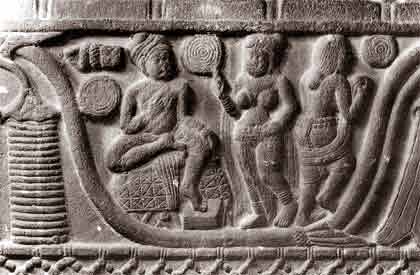 |
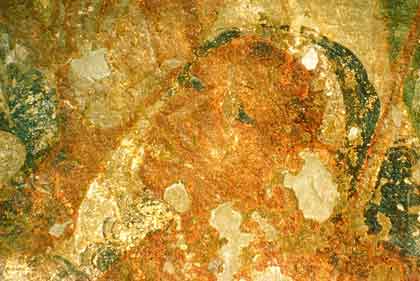 |
| Silavati in a mock admonition to Kusa for having hurled the elephant-dung on Pabhavati’s back. Pabhavati has turned her back to Kusa. Kusa-Jataka, Bharhut |
Pabhavati, Ajanta |
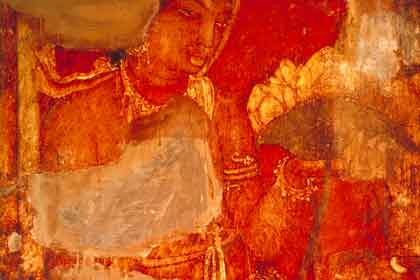 |
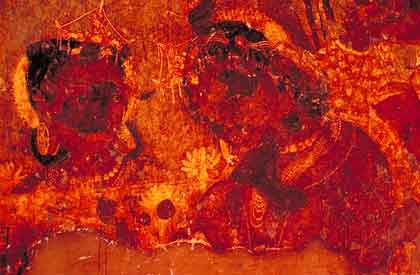 |
| Pabhavati in the lotus pond, Ajanta | Pabhavati taking a dip in the lotus pond, Ajanta |
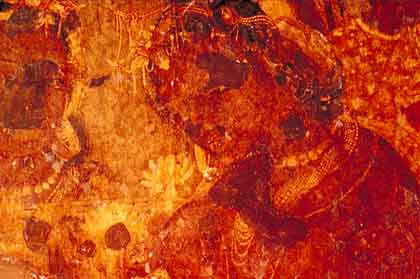 |
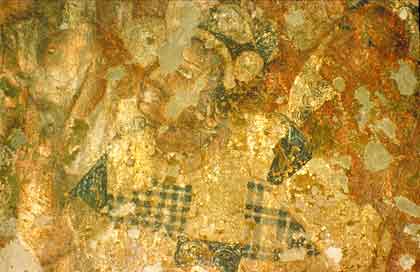 |
| Pabhavati taking a dip in the lotus pond (close up), Ajanta | Kusa hiding in the lotus pond and watching Pabhavati, Ajanta |
Dazzled by her beauty, Kusa’s desire to see her became more intense. Again, the queen mother organised a similar set up in the royal stable. Having seeing the gracious look of Pabhavati, the king playfully, this time, threw the horse dung on her back. Again the queen was furious and again was she pacified by her mother-in-law.
One day, Pabhavati, too, had a strong wish to see the king in person. So, she requested the queen mother to show her a glimpse of the king. Silavati then organised a royal procession where the king was seated behind his handsome younger brother Jayampati on a majestic elephant. When Pabhavati was looking at the procession through the palace window, Kusa caught hold of her glimpse. Again, he playfully made some amorous gesticulations at her to make her fret and fume. But soon it occurred to her that the person was the king as none could act so boldly. So, to ascertain the truth, she sent the hunch backed maid to examine the matter. When Kusa saw the maid approaching close to the procession he sensed something fishy. So, he called her and ordered her not to reveal his identity to her mistress. Upon return, the maid lied to Pabhavati. Thus, Pabhavati believed that she was married to Jayampati, the handsomest among all kings; and was proud of her luck.
One day, Kusa again asked his mother to show him his bride. So, the queen mother organised her visit to the royal lotus pond, where Kusa lay chin-deep behind a large lotus flower. When Pabhavati saw the laughing lotus flowers in the resplendent pond she shed all her clothes and jumped into the pond. Soon she swam to the large lotus behind which the king was hiding. As she looked irresistable with her exuberating and splashing beauty, the latter could not restrain himself longer and caught her by hand. He then whispered, “I am king Kusa, your husband”. The queen thought that she was caught by a goblin and swooned. The king then let her go.
Pabhavati was not a fool. When she regained consciousness and recalled the words of Kusa in the pond, she could easily correlate all the events ever since her first encounter with Kusa in the elephant stall; the stable; the royal procession; and finally in the lotus pond. Now, she knew the identity of the ugly man, who she met several times, and who was none other than her husband. She was terribly shocked. She felt beguiled and cheated. She was married to a man who looked most repulsive. Now, she discovered why was she forbidden to see the ugly man in the day-light. She sobbed but soon she thought that because she was young and pretty; and also a princess why not she should find a better suitor for herself. So, she soon organised a trip to her father’s kingdom and resolved never to return.
But Kusa followed her and finally won her back by his wisdom and prowess.
See Kusa Jataka Jataka Pali No.531. Cf. Anitthigandha or Chullapalobhana and Mahapalobhana Jataka; and Sammillabhasini of Ananusochiya Jataka.




